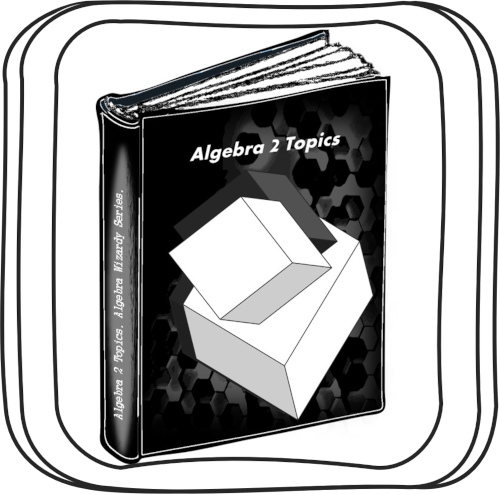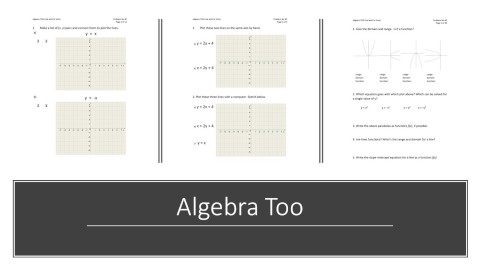Algebra 2 Topics
The Algebra 2 topics are described below in Plain English. You can also find the printouts here.

Algebra 2 Topics: Hands-On
The below list describes the major topics covered in a typical Algebra 2 class. You can learn about the below Algebra 2 topics in a set of printer-friendly worksheets, which follow after our algebra 1 worksheets.
The Topics:
Linear equations and plotting lines: The algebra 2 topics are largely focused around plotting different algebraic functions. We start with the simplest possible function, known as a line. This is just an everyday, straight line. And we learn how to plot it with paper and pencil.
Slope and point-slope equation for a line: Algebraic functions have parameters. For example, a line can be defined in terms of its slope, which you can think of as the angle of the line, and a second parameter called the intercept. The intercept, or more specifically the y-intercept, simply means where at the line touches the vertical y axis on a graph. We mean the equation of a line y = mx + b.
Parallel and perpendicular lines: Parallel lines never touch, and perpendicular lines intersect at right angles. There are simple tests to determine if lines are parallel or perpendicular.
Plotting and graphs: Lots of graphs can be made on paper or a computer. The algebra 2 topics focus on plotting in two dimensions, commonly known as x (horizontal) and y (vertical).
Polynomials and conic sections: Polynomials happen when x or y are raised to some power. Conic sections are the special case when the power on x or y is not greater than at 2. They are called conic sections because, interestingly, they are the type of shapes that would result from cutting up a cone.
Distance formula: Distance formula allows us to calculate how far apart are two points in space. It represents the distance between them.
Logarithms and Euler’s Number e: Logarithms are another way of representing exponents. Basically, logs allow us to invent new, convenient scales for the case when numbers get really, really big and/or really, really small and thus get out of control. There are base 10 logs based on the number 10, and also natural logs based on the number e. The number e is called Euler’s number. It appears frequently in science and mathematical modeling.
Imaginary, real, and complex numbers: Imaginary numbers happen for the seemingly impossible case of taking the square root of a negative number. Real numbers are just ordinary numbers that don’t suffer from this problem. A complex number combines the concept of real and imaginary numbers into a single, complex pair.
Vectors: Vectors represent directionality, motion, or force at some specific point. Mathematically, a vector is represented by an arrow. The tail is at some specific point, and the arrow points in a specific direction, usually representing a motion or force in that direction.
Matrices (plural of matrix): A two-dimensional matrix is a grid of data arranged into rows and columns. Matrices can have more than two dimensions, and they can be used to represent higher-dimensional problems in the real world. For example, it’s difficult to plot three-dimensional things on paper. However, matrices and matrix math can be used to analyze three dimensional things in our three-dimensional world and plot them using computer graphics on a screen. Or to control a 3D printer.
Solving systems of linear equations: An equation usually represents some kind of a constraint on a system. Real world systems can have many constraints, and thus many equations, not just one, needed for modeling. Using techniques such as matrix math, we can solve all the equations in just one step. This saves a lot of time, and this is how computers are programmed to do math quickly.
Modeling: Modeling, or mathematical modeling, means applying math to represent some sort of a real world system. Usually, equations can be used to create a graph or plot that represents how some thing behaves in the real world.
Sequences: A sequence is a pattern of numbers. Sequences are often introduced in algebra, but they are not really necessary until a more advanced type of math known as calculus.
Algebra 2 Topics NOT Covered in our Courses
Rational expressions: A rational expression happens when the variable x is in the denominator of a fraction. Interestingly, this is the one type of algebraic expression that computers have trouble analyzing. Therefore, modern algebra courses open place a heavy emphasis on rational expressions to check that students are not cheating by having the computer do all their work. In reality, rational expressions are fairly obscure.

